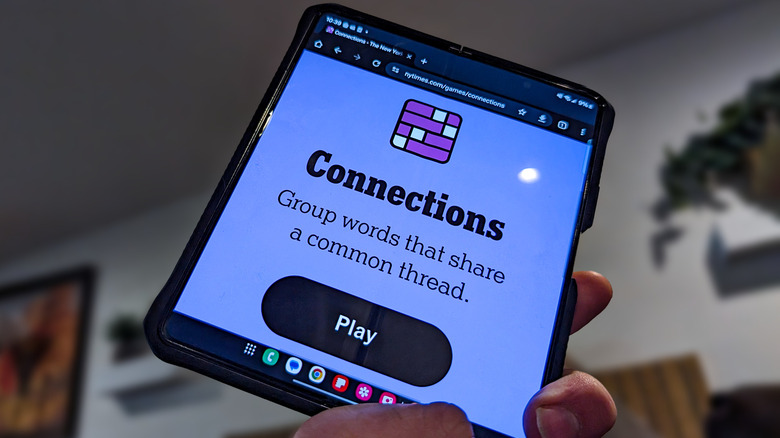Puzzle games have always enthralled fans with their special combination of challenge, inventiveness, and reason. One such fascinating game that puzzle aficionados have quickly come to adore is the Connections game. Whether your search is for “connections game today answers” or just wanting to get better, this book offers insightful analysis, techniques, and advice to help you master the game without compromising the experience for others or yourself.
Growing Popularity of the Connections Game
Puzzle aficionados have lately embraced games requiring both critical thinking and lateral insight. Part of this new set of challenges, the Connections game tests players to find hidden links among apparently unrelated phrases, images, or hints. Connections offers both cerebral activity and the delight of discovery, much as crossword puzzles or logic challenges appeal to our natural search for patterns in anarchy.
The simplicity of the Connections game on the surface combined with layers of complexity behind appeals to people. Every daily challenge that develops with every new puzzle makes players excitedly await the next chance to test their pattern identification and problem-solving ability.
Knowing the Game’s Mechanical Nature
Fundamentally, the Connections game gives you a collection of objects—words, images, or perhaps abstract hints. Your task is to cluster these objects according to a concealed relationship. The regulations are clear:
Every puzzle offers a defined set of objects.

Your objective is to arrange these objects into groups whereby each group shares a common theme or trait.
Simple categories—such as colors, objects, or animals—to more abstract or creative associations—the links can span both.
When you effectively group the objects, the underlying pattern or theme usually shows up and often results in a highly fulfilling “aha!.”
This framework is what makes the Connections game tough for experienced problem solvers as well as easily available for newcomers.
Approaches to Solving Today’s Challenge
If you’re searching for “connections answers today” in hopes of a shortcut, think about these techniques to enhance your experience and lead you toward the correct path without revealing the solution:
1. Review every item carefully.
Start by thinking through every word or image for all of its possible meanings. Many of the puzzle’s components could have several meanings, literal, metaphorical, or cultural ones included. This broad-minded approach guarantees that you won’t ignore a relationship concealed behind a double meaning or a popular connotation.
2. Note Typical Trends
Once you have examined the separate components, look for commonalities among them. Consider:
Of these, do any fit a comparable category—that is, fruit kinds, popular household objects, or city names?
Might the relationship be founded on a pun, same prefix, suffix, or perhaps a pun?
Exists a thematic element tying the objects—such as a historical event or common cultural reference?
Grouping is mostly about seeing these trends and validating your hypotheses against all the hints at hand.
3. Take Multiple Views
Often the most obvious link may not be the correct one. One should consider unconventional ideas. For example, a group of words might have a shared connotation in a certain context—such as a well-known movie or song title—that connects them not simply by their literal meaning. Try another approach until the pattern is obvious if one viewpoint does not result in a logical groupings.
4. Cut out red herrings
Red herrings—that is, objects that seem to fit more than one group—are common among puzzle designers. Their goal is to confuse your mental direction. Group things tentatively and make sure every item in your group makes sense. This will help you to control these. If anything seems pushed into a group, rethink where it belongs.
5. Get a Break as Needed
Faced with a difficult puzzle, one often develops a mental block. If you find yourself caught, back off for a few minutes. A little break helps you to clear your head and enable you to come back with fresh ideas. Often the best ideas come to you while you’re not trying to find a solution.
Getting Past Typical Mistakes
Playing the Connections game occasionally hooks even skilled problem solvers. These are several traps and how to stay clear of them:
Complication beyond what is necessary:
When the solution could be straightforward, it’s natural to obsess over the riddle and hunt for an unduly complicated relationship. Trust your gut feeling; if a simple grouping seems reasonable, investigate it deeper before thinking about more complex ideas.
Ignoring several meanings:
Many words have many meanings. Ignoring these several interpretations could send you in the wrong direction. Always consider whether an idiomatic phrase or homonym would help to link the objects.
Confirmation bias is:
Once you start to suspect a specific relationship, you may unintentionally make everything fit that story. Stay receptive to other groups and review your presumptions twice-through.
Fixing on one group:
Move on to another portion of the puzzle if one collection of objects proves too challenging to arrange. Often, finding one piece of the problem offers hints for later on resolution of the more difficult areas.
The People and the Pleasure of Discovery
Sharing your path with others is absolutely essential for the process of solving a challenge. Many aficionados searching for “connections game today answers” internet in quest of hints or validation. Though online groups might be helpful, nothing compares to the gratification of discovering the solution on your own.
Talk with other puzzle solvers.

Social Media and Forums:
Joining committed puzzle forums or social media groups offers a venue for conversation without compromising the problem. Members frequently provide tips and techniques meant to guide you in the proper path.
Talk about ideas:
Sometimes talking about your mental process with a friend could lead to fresh insight. Speaking out loud about your thinking could highlight a link you hadn’t thought about previously.
Honor the “Aha!!” Events:
Finding the right groups is only one aspect of the real satisfaction in completing the Connections game—the path of discovery is also. Accept the difficulty and savor every second of that epiphany when the components at last line together.
Improving Your Puzzle-Solving Skills
Improving at the Connections game develops skills that apply to all spheres of critical thinking and creativity, not only to completing one puzzle.
These ideas help you to increase your capacity:
consistent Practice
Solving more problems helps you to becoming more skilled in spotting trends. Develop the habit of everyday interacting with the Connections game or related puzzles. You will find some techniques second nature over time.
From Every Experience, Learn
Every puzzle offers a teaching moment. Review your approach even if you do not find a flawless solution:
Which links you overlooked?
Exists any red herding that distorted your perspective?
In what other ways may you have arranged the objects?
Considering these issues can help you to perform better in the future.
Develop Your General Knowledge
Your ability to solve problems will be much improved by a broad knowledge base. You can make more connections the more knowledge you have about several disciplines—including history, popular culture, science, or language. Read widely and you may discover that an obscure fact from one field suddenly provides the key to solve a problem in another.
Spread Your Puzzle Routine Across Different Areas
Don’t let one kind of puzzle define you. Investigating several puzzle forms, including logic puzzles, Sudoku, and crossword puzzles, will help you hone many facets of your ability to solve problems. When you approach the Connections game, this cross-training can help you to be more flexible and creative.
Solving “Connections Game Today Responsibly”
Especially if you have been looking for “connections answers today” on your preferred search engine, it is natural to be interested about whether you are on the right road. Still, keep in mind that depending just on direct answers can lessen the whole puzzle experience. These pointers will help you to keep your path interesting:
Emphasize the process.
Focus on appreciating the process of thinking and learning instead than obsessing just on the end response. Solving the riddle makes one happy not just at the end but also in the trip.
Seek hints, not answers.
Should you find yourself really caught, search for suggestions instead of whole solutions. Many problem groups provide small nudges in the correct direction without revealing the complete answer.
Honor the community’s integrity.
Online communities live on the common experience of perplexing. Fighting the need to post straight responses helps to preserve a setting in which everyone may enjoy the challenge and grow together.
Last Notes: Accept the Task
The Connections game celebrates inventiveness, reason, and the delight of discovery—not only a daily problem. Using the above mentioned techniques not only increases your chances of solving the puzzle but also increases your respect of the complex design underlying every difficulty.
Whether you’re painstakingly going through the clues or just browsing casually for “connections game today answers,” the real benefit is the mental workout and personal gratification that results from solving the puzzle on your own. Every puzzle offers a different chance to challenge your mind, investigate fresh connections, and honor the moment when everything at last clicks.
Thus, the next time you sit down to play the Connections game, inhale deeply, rely on your gut feeling, and savor every turn of the road. Happy solving; maybe your road to knowledge will be as fulfilling as the answer itself!
140 characters for the meta description:
“Explore professional techniques, suggestions, and tips for tackling today’s Connections game challenge. With inventive insights, unlock your capacity for puzzle-solving!
connections game today answers,
connections answers today
